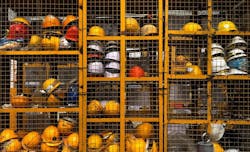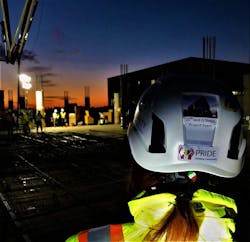It has taken 56 years for the 1964 Civil Rights Act to finally protect civil rights for all. On June 15, 2020, the Supreme Court ruled that LGBTQ individuals cannot be fired because of their sexuality or gender identification. This is a huge step for the LGBTQ community who are finally able to not be fired from a job simply for being themselves. Judge Neil M. Gorsuch wrote in his ruling “An employer who fires an individual merely for being gay or transgender defies the law.” Bostock v. Clayton County, 590 U.S. (2020). The construction industry certainly has its fair share of America’s estimated 8 million (or more) LGBTQ workers – in design firms, in office and management positions, and on the job site. Like any other industry, it will be changed profoundly by this ruling. This is a major step for the millions of LGBTQ individuals in the US, but it is still only a steppingstone to real equality.
While governments can legislate actions and directions, they cannot legislate attitudes. This means plenty of obstacles remain for LGBTQ people seeking full inclusion and equality in construction. According to Bryce Tache, Diversity and Inclusion Leader Ryan Companies US, “The truth is that there have always been many LGBTQ people working alongside us, and maybe more people will now feel it’s safer to be themselves at work. But that is going to require a lot of intentional work to create truly safe, inclusive workplaces.” This is certainly true for those working in offices, but there may be particular issues for the lion’s share of construction industry employees who work side-by-side on the job site.
Breaking Down Stereotypes
The construction industry is no stranger to negative stereotypes and the detriment they cause. It is not uncommon for construction field personnel to be seen as “brute” or even “second class”. But the truth is, skilled laborers do a lot more than just “swinging hammers” – our workforce is made up of motivated and detail-oriented teams who thrive by being creative and innovative, shaping the world that we live in. Careers in construction require apprenticeships, on-the-job training, and lots of physical demands. Getting into this line of work is an active choice, yet more and more often it is seen as a last resort – young people are losing interest in the trades at the very time when demand for skilled workers is growing. All harmful stereotypes associated with construction work will make it harder to close that gap. If construction workers want to collaborate with the best in the industry, they should be encouraging everyone to see others through the lens of skills, motivation, and teamwork, not one’s gender identity or sexual orientation. Acknowledging stereotypes and breaking those down will be a huge first step towards further equality on the construction site. Furthermore, employers must create an all-inclusive work culture. “These messages need to come from the top. Silence from leadership is a message – and it’s not the right message.”, says Tache. Tache and fellow leaders at Ryan are not staying silent. He says, “Our CEO wrote a pledge last year that all employees are encouraged to sign. It asks us to each be the person who tells a fellow team member, partner, vendor, or client to ‘knock it off’ when we hear course language or offensive jokes, or when we see inappropriate behavior. It encourages each of us do the right thing and set the tone, and to treat each other as family regardless of someone’s gender, race, sexual orientation, age, or anything else.”
The Unseen Danger on our Job Sites
From an occupational health and safety perspective, we can all agree that job sites are a dangerous work environment. However, there is an unseen danger that deserves attention – and that is mental health. Everyday minorities, especially for minorities of the LGBTQ community face a specific stigma. This stigma creates a hostile work environment, an impaired self-image, and high stress levels that can result in mental health problems. The need to conceal one’s identity perceived by so many LGBTQ people can be one of the greatest sources of stress an individual may face. And so it is perhaps not surprising in hindsight that a CDC report issued earlier this year found that construction workers unfortunately have the nation’s highest rates of suicide. Few jobs are more collaborative than construction work. A sense of inclusion is vital to making that collaboration work. Yet 53% of LGBTQ workers report overhearing “gay” as an insult in the workplace. Jokes based on sexual orientation or gender identity are still all too common. It is vital that LGBTQ workers no longer hide their true identity, but it is even more crucial that they embrace who they are in the workplace. Maximilian Hartman, Senior VDC Engineer at Gilbane Building Company in New York City, serves as Gilbane’s National Chair of Pride Employee Resource Group. Max says, “Gilbane has started with some small things like stickers on hard hats and posters that read BE AN ALLY – It’s important to be out and to be visible. If someone knows your sexual orientation they might think twice before using inappropriate language around you. It is important to not be complaisant and stop people in their tracks when they say something offensive.”
Securing the Job
An employer may find it easier to conceal his or her discrimination during the hiring process than once the individual has accepted a job offer. Nepotism exists, and while not always a bad thing for minorities, should the hiring manager be a fellow minority, a cis male hiring manager is still more likely to hire an underqualified fellow cis male in preference to a more qualified trans woman for the same position (cis is a term for people whose gender identity matches their sex assigned at birth). This could also be furthered by a non-inclusive work culture, where introducing minorities could be perceived to cause workplace discomfort amongst the cis majority of workers. These issues must be addressed by employers and an all-inclusive work culture must exist.
Lead the Movement
We point out these remaining barriers not to discourage anyone, but to encourage further thought and action. Identifying these hurdles is a first step to overcoming them. June has been a landmark month in the history of LGBTQ rights in America, with this year being no different thanks to the long-awaited decision by the Supreme Court. Yet it is not enough to stand back and celebrate. Our work did not end on June 30th. It continues today in July, and every day after. We can all use the Supreme Court historical ruling to empower ourselves to do more, to call out inappropriate language or behavior – maybe even to examine our own language or behavior – and make the industry more inclusive for all. Setting a work culture that is aware of everyone’s differences and similarities is crucial to progress. It is time to work together, not against each other.
About the Author:
Grady Schutt is a VDC Engineer at VIATechnik in New York City. His passion for technology, construction and people drives him to be a young positive voice in the AECO industry. With his Bachelor of Engineering & Applied Sciences from the University Cincinnati his goal is to use technology to implement processes that empower construction professionals to achieve their goals.
About VIATechnik:
VIATechnik is the global leader in virtual design and construction, with nearly 200 digital experts in nine global offices. We are on a mission to transform the analog world of design and construction into a digital platform, enabling efficient design, industrialized construction, and a digital real estate service model. Through this transformation, we believe we can solve the world’s housing and infrastructure challenges, deliver spaces that nurture life, commerce, and relationships. The VIATechnik leadership wants the industry to know that now and forever, we are One Team.
About the Author
VIATechnik
VIATechnik is the global leader in virtual design and construction, on a mission to transform the analog world of design and construction into a digital platform, enabling efficient design, industrialized construction, and a digital real estate service model. Through this transformation, we believe we can solve the world’s housing and infrastructure challenges, deliver spaces that nurture life, commerce, and relationships. The Edge is VIATechnik's blog where our team shares our experiences and explores ideas that create real impact on the built world. Follow us on Facebook, LinkedIn, and Twitter.


